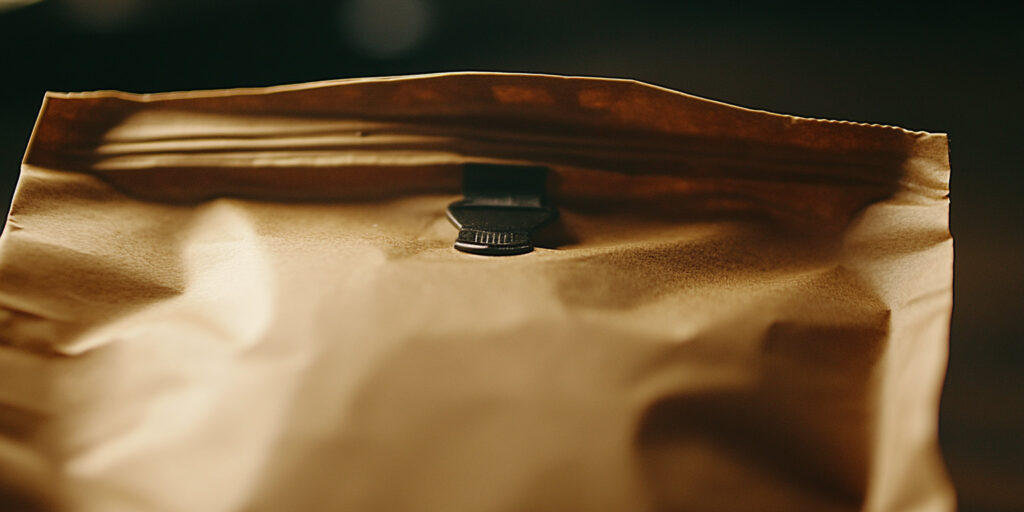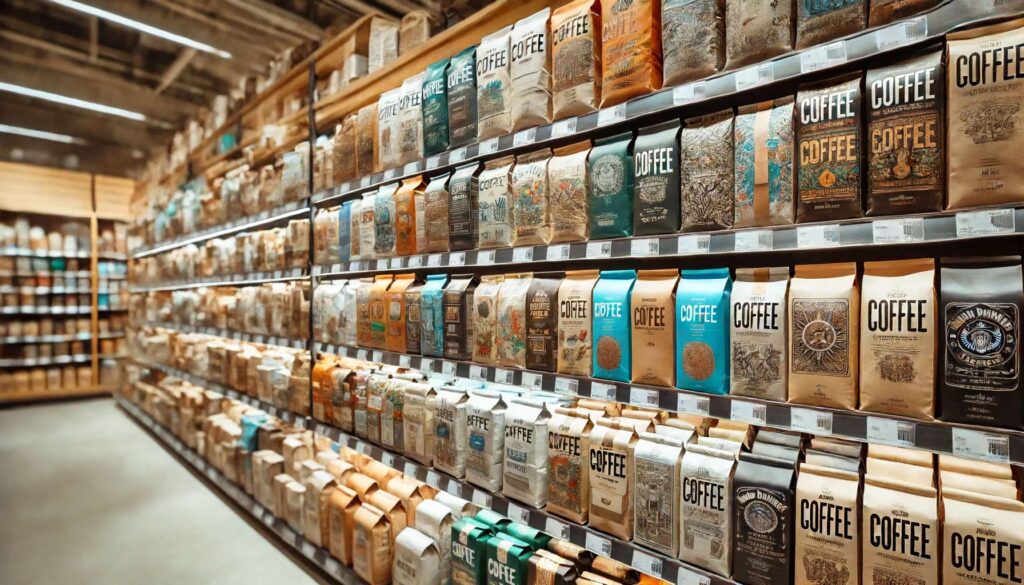
Consideraciones clave en la selección de materiales
Al elegir el material adecuado para el empaque de café, preservar la frescura es esencial. La vida útil del café depende en gran medida del material del empaque. Opciones flexibles como películas multicapa, papel kraft y papel aluminio ofrecen beneficios únicos. El aluminio brinda una excelente barrera contra la humedad, el oxígeno y la luz, factores que pueden deteriorar la calidad del café. El papel kraft, aunque ecológico, requiere laminado para ofrecer el mismo nivel de protección. Las películas multicapa, que suelen combinar distintos materiales, logran un equilibrio entre protección y flexibilidad, permitiendo una vida útil prolongada sin comprometer la sostenibilidad.
Lista de materiales para empaques de café y sus características destacadas
1. Bolsas de papel aluminio
- Destacados:
- Excelente barrera contra la humedad, el oxígeno y la luz.
- Proporciona la mayor vida útil para el café.
- Muy duradero y protege contra factores ambientales.
- A menudo se combina con otros materiales para mayor flexibilidad.
2. Películas plásticas multicapa
- Destacados:
- Combina diferentes capas de plástico para mayor protección.
- Flexible y personalizable en formas y diseños.
- Fuerte barrera contra el oxígeno y la humedad.
- Ideal para impresión de alta calidad y branding.
3. Papel kraft con revestimiento
- Destacados:
- Ecológico y biodegradable.
- Requiere un revestimiento plástico o de aluminio para protección.
- Apariencia rústica y consciente del medio ambiente.
- Puede ser laminado para mejorar la resistencia a la humedad.
4. Películas biodegradables y compostables
- Destacados:
- Hechas de materiales vegetales como PLA o almidón.
- Sostenibles y compostables.
- Ideales para marcas enfocadas en empaques ecológicos.
- Barrera limitada comparada con materiales tradicionales.
5. Bolsas de polietileno (PE)
- Destacados:
- Ligeras y duraderas.
- Buena resistencia a la humedad.
- Flexibles y fáciles de personalizar.
- Se usan a menudo junto con otras capas para mejorar la protección.
6. Empaque sellado al vacío
- Destacados:
- Elimina completamente el aire, reduciendo la oxidación.
- Prolonga la vida útil del café al evitar la exposición al oxígeno.
- Requiere equipo especializado para sellado.
- Se usa comúnmente para almacenamiento premium o prolongado.
7. PET (Tereftalato de polietileno) con papel aluminio
- Destacados:
- Alta resistencia e impacto.
- Común en cápsulas o pods de café.
- Excelente barrera contra oxígeno y humedad.
- A menudo se usa con válvulas desgasificadoras para mayor frescura.
8. Frascos de vidrio
- Destacados:
- Rígidos y duraderos, protegen contra daños físicos.
- Permiten sellos herméticos para evitar la oxidación.
- Reutilizables y ecológicos.
- Transparentes, por lo que pueden necesitar tinte o envoltura para bloquear la luz.
9. Bolsas de papel con cierre metálico (tin-tie)
- Destacados:
- Fáciles de volver a cerrar gracias al cierre incorporado.
- Populares para ventas minoristas.
- Vida útil limitada si no están forradas.
- Ofrecen una estética artesanal y tradicional.
10. Bolsas tipo stand-up con cierre zip
- Destacados:
- Reutilizables con cierres prácticos.
- Flexibles y aptas para branding personalizado.
- Generalmente hechas con plásticos multicapa para proteger contra humedad y oxígeno.
- Mantienen la frescura después de abrirse.
11. Bolsas de papel forradas con aluminio
- Destacados:
- Combinan la sostenibilidad del papel con la protección del aluminio.
- Ligeras y fáciles de apilar.
- Ideales para almacenamiento a corto plazo y ventas retail.
- Se pueden sellar con calor para una capa extra de protección.

Comparación de durabilidad del material y vida útil
Cada material de empaque ofrece distintos niveles de durabilidad y afecta de manera diferente la vida útil del café. El papel aluminio proporciona una de las vidas útiles más largas, ya que es altamente resistente al oxígeno y la humedad. Los plásticos multicapa también ofrecen una excelente durabilidad y mayor flexibilidad, lo que permite diseños y estampados personalizados. Por otro lado, el papel kraft, aunque es amigable con el medio ambiente, no extiende la vida útil del producto a menos que se combine con un revestimiento plástico o de aluminio. Al seleccionar el material de empaque, es importante equilibrar la sostenibilidad con la necesidad de mantener la frescura por más tiempo.
La importancia de las válvulas desgasificadoras en el empaque de café
El café recién tostado libera gases, especialmente dióxido de carbono, que pueden acumularse dentro de un empaque sellado y afectar el sabor y aroma del café. Las válvulas desgasificadoras son esenciales en el diseño de bolsas de café, ya que permiten que estos gases escapen sin dejar entrar aire. Sin esta válvula unidireccional, las bolsas podrían explotar o, peor aún, el café podría perder su frescura y sabor característico. Incluir una válvula desgasificadora no solo prolonga la vida útil del café, sino que también garantiza que llegue al consumidor en su mejor estado.

Temperatura: un factor clave en el almacenamiento del café
Más allá del material del empaque, la temperatura a la que se almacena el café juega un papel crucial en la conservación de su frescura. El café se debe mantener en un lugar fresco y con temperatura constante, lejos de fuentes de calor o luz solar directa. Aunque congelar el café puede extender su vida útil, esto se recomienda solo para almacenamiento a largo plazo, ya que las variaciones de temperatura pueden generar condensación dentro de la bolsa. Para obtener mejores resultados, es ideal usar materiales de empaque como películas multicapa o papel aluminio, que ofrecen resistencia térmica y protegen el café de cambios bruscos de temperatura.
Impacto ambiental y sostenibilidad de las opciones de empaque
A medida que los consumidores se vuelven más conscientes del medio ambiente, la sostenibilidad del empaque de café se ha convertido en un factor clave. Materiales como el papel kraft y las películas biodegradables ofrecen alternativas ecológicas, aunque pueden comprometer la vida útil del producto. Por otro lado, el aluminio y las películas multicapa, aunque menos sostenibles, brindan una mayor protección al café frente a factores como la humedad y el oxígeno. Se puede lograr un equilibrio entre sostenibilidad y protección eligiendo materiales reciclables o fabricados a partir de recursos renovables.
Otros factores a considerar: personalización y marca
El empaque del café no solo protege el producto, también comunica la identidad de la marca en el punto de venta. Las películas multicapa ofrecen más versatilidad para la personalización, permitiendo impresiones de alta calidad. El papel aluminio también permite gráficos llamativos, pero es menos flexible para crear diferentes formas de empaque. El papel kraft, aunque limitado en opciones de color, puede imprimirse con tintas ecológicas, lo cual resulta atractivo para los consumidores comprometidos con el medio ambiente. Al seleccionar un empaque, es clave equilibrar aspectos prácticos como la vida útil con el impacto visual para destacar en un mercado competitivo.

